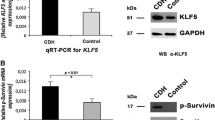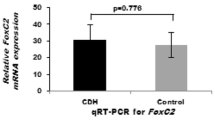Abstract
Background
The precise mechanism of pulmonary hypoplasia associated with congenital diaphragmatic hernia (CDH) still remains unclear. Recently, prenatal treatment with retinoic acid (RA) has been reported to stimulate alveologenesis in hypoplastic lungs in the nitrofen model of CDH. The serine/threonine protein kinase B (AKT) plays a key role in lung morphogenesis through epithelial–mesenchymal interaction in phosphatidylinositide 3-kinase (PI3K)-dependent manner. It has been reported that the lung morphogenesis in explants in mice is interfered by inhibitors of PI3K–AKT signaling pathway. Furthermore, we have recently shown that nitrofen inhibits PI3K–AKT signaling during mid-to-late lung morphogenesis in the nitrofen-induced hypoplastic lung. We hypothesized that prenatal administration of RA upregulates pulmonary gene expression of PI3K and AKT in the nitrofen-induced hypoplastic lung.
Methods
Pregnant rats were exposed to either olive oil or nitrofen on day 9 of gestation (D9). 5 mg/kg of RA was given on D18, D19 and D20. The fetuses were harvested on D21, and fetal lungs were obtained and divided into four groups: control, control + RA, nitrofen, nitrofen + RA. The mRNA expression levels of PI3K and AKT were analyzed in each lung by real-time RT-PCR and statistically analyzed. Immunohistochemistry was also performed to evaluate protein expression of PI3K and AKT in the fetal lungs at D21.
Results
The pulmonary gene expression levels of PI3K and AKT were significantly upregulated in nitrofen + RA group compared to nitrofen group and control + RA group (p < 0.05), whereas there were no significant differences between controls and control + RA group. Immunoreactivity of PI3K and AKT was markedly increased in nitrofen + RA lungs compared to nitrofen-induced hypoplastic lungs.
Conclusions
Upregulation of PI3K and AKT genes after prenatal treatment with RA in the nitrofen-induced hypoplastic lung suggests that RA may have a therapeutic potential in modulating lung alveologenesis by stimulating epithelial–mesenchymal interaction via PI3K–AKT signaling.

Similar content being viewed by others
References
Doyle NM, Lally KP (2004) The CDH Study Group and advance in the clinical care of the patient with congenital diaphragmatic hernia. Semin Perinatol 28:174–184
Ivascu FA, Hirschl RB (2004) New approaches to managing congenital diaphragmatic hernia. Semin Perinatol 28:185–198
Grosche JR, Islam S, Boulanger SC (2005) Congenital diaphragmatic hernia. Am J Surg 190:324–332
Kluth D, Kangah R, Reich P et al (1990) Nitrofen-induced diaphragmatic hernias in rats: an animal model. J Pediatr Surg 25:850–854
Doi T, Puri P (2009) Up-regulation of Wnt5a gene expression in the nitrofen-induced hypoplastic lung. J Pediatr Surg 44:2302–2306
Doi T, Hajduk P, Puri P (2009) Upregulation of Slit-2 and Slit-3 gene expressions in the nitrofen-induced hypoplastic lung. J Pediatr Surg 44:2092–2095
Sato H, Murphy P, Hajduk P (2009) Sonic hedgehog gene expression in nitrofen induced hypoplastic lungs in mice. Pediatr Surg Int 25:967–971
McCaffery PJ, Drager UC et al (2000) Retinoids in embryonal development. Physiol Rev 80:1021–1054
Maden M (2004) Retinoids in lung development and regeneration. Curr Top Dev Biol 61:153–189
Noble BR, Babiuk RP, Clugston RD et al (2007) Mechanisms of action of the congenital diaphragmatic hernia-inducing teratogen nitrofen. Am J Physiol Lung Cell Mol Physiol 293:L1079–L1087
Nakazawa N, Takayasu H, Montedonico S et al (2007) Altered regulation of retinoic acid synthesis in nitrofen-induced hypoplastic lung. Pediatr Surg Int 23:391–396
Nakazawa N, Montedonico S, Takayasu H et al (2007) Disturbance of retinol transportation causes nitrofen induced hypoplastic lung. J Pediatr Surg 42:345–349
Doi T, Sugimoto K, Puri P (2009) Up-regulation of COUP-TFII gene expression in the nitrofen-induced hypoplastic lung. J Pediatr Surg 44:321–324
Montedonico S, Nakazawa N, Puri P (2006) Retinoic acid rescues lung hypoplasia in nitrofen-induced hypoplastic foetal rat lung explants. Pediatr Surg Int 22:2–8
Montedonico S, Sugimoto K, Felle P et al (2008) Prenatal treatment with retinoic acid promotes pulmonary alveologenesis in the nitrofen model of congenital diaphragmatic hernia. J Pediatr Surg 43:500–507
Doi T, Sugimoto K, Puri P (2009) Prenatal retinoic acid up-regulates pulmonary gene expression of COUP-TFII, FOG2, and GATA4 in pulmonary hypoplasia. J Pediatr Surg 44:1933–1937
Rameh LE, Cantley LC (1999) The role of phosphoinositide 3-kinase lipid products in cell function. J Biol Chem 274:8347–8350
James SR, Downes CP, Gigg R et al (1996) Specific binding of the Akt-1 protein kinase to phosphatidylinositol 3, 4, 5-trisphosphate without subsequent activation. Biochem J 315:709–713
Wang J, Ito T, Udaka N et al (2005) PI3K–AKT pathway mediates growth and survival signals during development of fetal mouse lung. Tissue Cell 37:25–35
Doi T, Ruttenstock E, Dingemann J et al (2009) Spatio-temporal alteration in PI3K–AKT signalling in the nitrofen induced hypoplastic lung. J Pediatr Surg (in press)
Uruno A, Sugawara A, Kanatsuka H (2005) Upregulation of nitric oxide production in vascular endothelial cells by all-trans retinoic acid through the phosphoinositide 3-kinase/Akt pathway. Circulation 112:727–736
Massaro GD, Massaro D (1996) Postnatal treatment with retinoic acid increases the number of pulmonary alveoli in rats. Am J Physiol 270:L305–L310
Hind M, Maden M (2004) Retinoic acid induces alveolar regeneration in the adult mouse lung. Eur Respir J 23:20–27
Major D, Cadenas M, Fournier L et al (1998) Retinol status of newborn infants with congenital diaphragmatic hernia. Pediatr Surg Int 13:547–549
Farias EF, Marzan C, Mira-y-Lopez R (2005) Cellular retinol-binding protein-I inhibits PI3K/Akt signaling through a retinoic acid receptor-dependent mechanism that regulates p85–p110 heterodimerization. Oncogene 24:1598–1606
Author information
Authors and Affiliations
Corresponding author
Rights and permissions
About this article
Cite this article
Doi, T., Sugimoto, K., Ruttenstock, E. et al. Prenatal retinoic acid upregulates pulmonary gene expression of PI3K and AKT in nitrofen-induced pulmonary hypoplasia. Pediatr Surg Int 26, 1011–1015 (2010). https://doi.org/10.1007/s00383-010-2654-x
Published:
Issue Date:
DOI: https://doi.org/10.1007/s00383-010-2654-x




